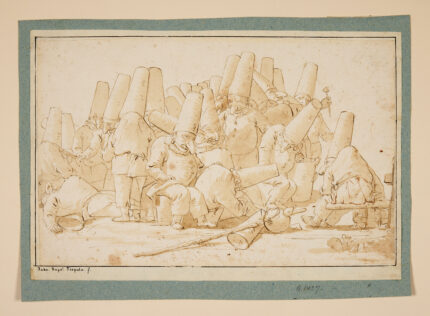A drawing by Rococo master Giovanni Battista Tiepolo has been rediscovered in the attic of Weston Hall, the Northamptonshire seat of the literary Sitwell family. The pen, ink and wash drawing depicts a group of Punchinelli, a buffoonish commedia dell’arte stock character that Tiepolo drew repeatedly from the late 1720s through the early 1760s. This is an earlier example, dating to the early 1730s, and is one of the largest, most populated and most detailed of the three dozen or so Tiepolo Punchinello drawings.
Tiepolo, in contrast to his son Domenico, who shows Punchinelli engaged in everyday activities in his Divertimento per li Regazzi, portrays his Punchinelli making and eating gnocchi, and suffering from the excesses of overindulgence. The subject derives from a regional festival, “venerdì gnoccolare”, which took place in Verona on the last Friday of Carnival.
George Knox, the Tiepolo art historian, suggests that this drawing is among the earliest of the Punchinello drawings because of its fine line and delicate, even use of wash. He further proposes that this drawing may be linked stylistically with the studies for the Villa Loschi at Biron, executed around 1734. The present drawing, and others of this period, undoubtedly mark the moment that Tiepolo’s draftsmanship assumes its mature form.
The drawing was acquired by Sir Osbert Sitwell at a Christie’s auction of the famous collection of Old Master drawings of the late London banker and art collector Henry Oppenheimer in July 1936. For some inexplicable reason, the drawing wound up forgotten in one of Weston Hall’s attics. It was only rediscovered last year when Henrietta Sitwell, Osbert’s grand-niece, found it leaning against the attic wall and peeled back the bubble wrap it was swaddled in to find a surprise Old Master.
The Tiepolo drawing will go under the hammer at Dreweatts auction house with the other contents of Weston Hall at a two-day sale on November 16th and 17th. It has been conservatively estimated to sell between £150,000-£250,000 ($207,000-344,000), but a comparable piece sold at auction in New York in 2013 for $542,500, so even the high end of the range is something of a low-ball figure.

…Very cool, but that drawing is not even a large one 😉
———-
In the reception room of the Würzburg Residence, there is a massive fresco created 1750-53 by Giovanni Battista Tiepolo, depicting allegorically the four continents: Europe, America, Asia and Africa.
Unfortunately, there was no fifth corner for Australia. The staircase gained importance as part of the formal reception room. It spans its vault, an area of 18 × 32 meters, without pillars.
Beneath an unsupported trough vault with a maximum height of 23 meters. The lowest part of the stair leads away from the reception hall, and then splits into two stairs which double back. Thus, the host on the upper landing was able to see his visitor first, who initially walked away from him. As the guest turned and approached, the vast ceiling fresco above –incl. the vault 677 m^2– was increasingly revealed to the visitor.
As a result of a massive WWII air raid on 16 March 1945, the residence was almost completely burnt out and only the central building with the Vestibule, Garden Hall, Staircase, White Hall and Imperial Hall survived the inferno.
Luckily, by June 18th, however, US army officer John Davis Skilton had a wooden protection installed. Thus, in 1945, the kick-off for a full restoration had been set.
———-
en.wikipedia.org/wiki/Würzburg_Residence#Staircase
upload.wikimedia.org/wikipedia/commons/d/dd/Bundesarchiv_B_145_Bild-F079088-0003,_Würzburg,_Residenz.jpg
upload.wikimedia.org/wikipedia/commons/f/fc/Tiepolo-residenz-wuerzburg.jpg
upload.wikimedia.org/wikipedia/commons/f/f6/Residenz_Wuerzburg_Vorderan.jpg
“diatretic” What does it mean? My OED (not the largest, but not the smallest, either), does not list it. But does show that the “trem” root might mean something related to a hole while “dia” usually means “through”. The combination “through hole” does not seem apt for this object, however.
Website owner please respond.
1. Your comment is not germane to this post.
2. Why is it the “website’s owner” responsibility to explain etymology of a word you don’t understand?
3. Look up word “reticulated”.
Is ‘punchinello’ the source of “Punch ‘n’ Judy’?
This masterful sketch and delicate wash is truly hilarious, true to life, when you examine each agonized expression of overindulgence.
“GREEK, –Do You SPEAK it??!?” 😎
Have a look at the glass vessel from the previous post. I am not the “owner”, but here you go:
διά (dia) = “through”, while τρητός (tretos) = “perforated, with a hole in it”. Together, that gives διάτρητος (diatretos) = “bored through, pierced” –or in other words– “diatretic” (τρυπανίζω = bore through).
Do a ‘picture search’ for “Walenzeichen”, cf. (German) de.wikipedia.org/wiki/Walen – Unsure about “Punch and Judy”, there is a historical reference to “Snow White” and particularly the “Seven Dwarfs“:
From Venice, there were mining explorers secretly active north of the Alps, a.k.a. “Venedigermännlein” (“Little Men from Venice”).
Off duty, and drunk during carnival, they might have looked exactly like the ones in the drawing :no:
Why the snarky reply to someone who posted a question on the wrong thread?
diatretic vase, meaning that it is constructed from reticulated glass
Yes. The correct name of the character is Pulcinella, from Naples.